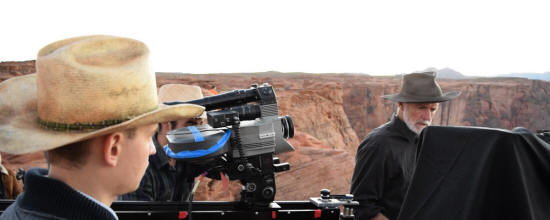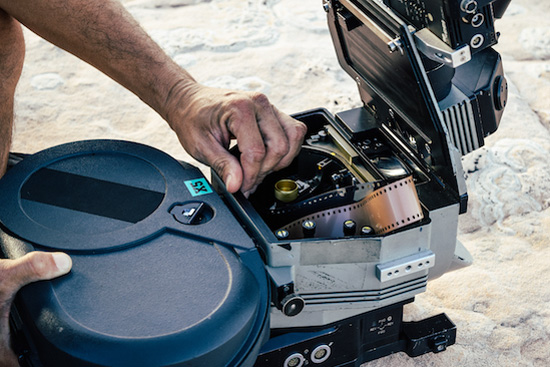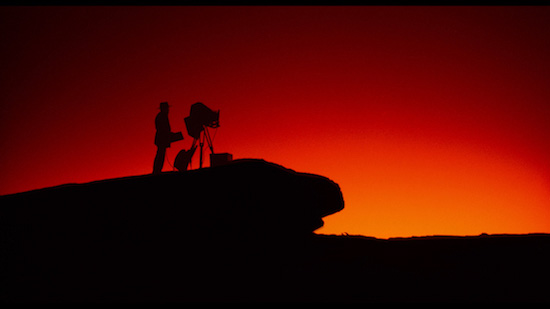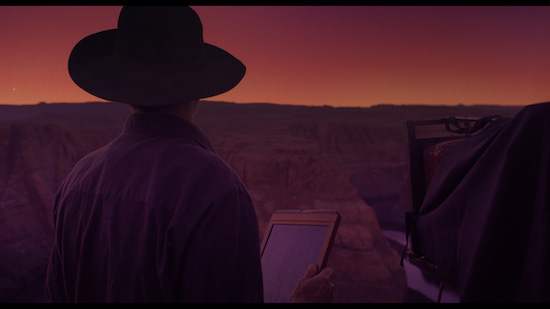"The Negative" - VistaVision Strikes Back |
Read more at in70mm.com The 70mm Newsletter |
| Written and Photographed by: David Harvilla & Jack Winemiller | Date: 02.04.2017 |
 Large format movie making has been on the rise lately. From major Hollywood
blockbusters shooting sequences in 65mm, the re-birth of
70mm roadshows and with
the recent appearance of the large format
Alexa 65 digital camera, the landscape
for large format filmmaking has indeed changed. Yet, one format remains
forgotten: VistaVision. This legendary format dates back to 1954 when Paramount
Pictures invented it in response to CinemaScope. VistaVision is a process that
takes traditional 35mm film and literally turns it on its side. In contrast to
conventional 35mm motion picture film, which pulls film vertically at four
perforations per frame, the VistaVision camera records images horizontally along
the length of 35mm film at eight perforations per frame. This creates an image
twice the size of standard 35mm film with better resolution and much smaller
grain size. The format was later used in the 1970s by Industrial Light & Magic
to create the special effects shots for George Lucas'
"Star Wars". Now, thanks to
three San Diego State University filmmakers, and the support of famed producer
and president of Lucasfilm, Kathleen Kennedy, VistaVision has seen a minor
rebirth. Large format movie making has been on the rise lately. From major Hollywood
blockbusters shooting sequences in 65mm, the re-birth of
70mm roadshows and with
the recent appearance of the large format
Alexa 65 digital camera, the landscape
for large format filmmaking has indeed changed. Yet, one format remains
forgotten: VistaVision. This legendary format dates back to 1954 when Paramount
Pictures invented it in response to CinemaScope. VistaVision is a process that
takes traditional 35mm film and literally turns it on its side. In contrast to
conventional 35mm motion picture film, which pulls film vertically at four
perforations per frame, the VistaVision camera records images horizontally along
the length of 35mm film at eight perforations per frame. This creates an image
twice the size of standard 35mm film with better resolution and much smaller
grain size. The format was later used in the 1970s by Industrial Light & Magic
to create the special effects shots for George Lucas'
"Star Wars". Now, thanks to
three San Diego State University filmmakers, and the support of famed producer
and president of Lucasfilm, Kathleen Kennedy, VistaVision has seen a minor
rebirth.Their film, "The Negative", is about a large format still photographer and his journey in the wilderness of the American West. The film is a love letter to the John Ford western "The Searchers", which stars John Wayne. "The Searchers" was filmed in Monument Valley, a red-sand desert region on the Arizona-Utah border, which the production team of "The Negative" also chose as their shooting location. The scale of the landscape and theme of The Negative called for an epic shooting format. After exploring different options and formats, the filmmakers decided to originate the film on VistaVision. Cinematographer Ziryab Ben-Brahem spent months preparing the project in collaboration with director Mate Boegi, producer David Harvilla, and 1st AC Jose De Matos. With no funds to get started, the production team received help from the executive producer for Steven Spielberg, Kathleen Kennedy. Lo and behold, the team received a check in the mail and production of "The Negative" was off to a strong start. |
More in 70mm reading: Ziryab Ben-Brahem in70mm.com's page about VistaVision 65mm Horror Short "Daughter of Dismay" The Making of ‘Ellston Bay’ Horizontal VistaVision Projector |
VistaVision: The Gold Standard of 35mm Filmmaking |
|
 While other large formats require 65mm film and special laboratories,
VistaVision uses 35mm film and can be processed by almost any motion picture lab
in the world. The team worked with Cinelab, a full-service film lab and one of
the last surviving film labs in North America. While other large formats require 65mm film and special laboratories,
VistaVision uses 35mm film and can be processed by almost any motion picture lab
in the world. The team worked with Cinelab, a full-service film lab and one of
the last surviving film labs in North America.The production team used a Beaumont VistaVision camera that had just been returned from being used on the James Bond movie "Spectre", so they were confident it would work. There are only a handful of these cameras in the world and each one of them is built slightly differently. Cinematographer Ziryab Ben Brahem, winner of the Kodak Cinematography Award, spoke about the challenges of shooting, printing, and projecting in the VistaVision format for the first time in decades. Ziryab explained, “While the 35mm negative was familiar to all of us, none of our crew had ever worked with a Beaumont VistaVision camera. To add to that, at the time no one had ever attempted to actually use the Beaumont VistaVision camera as an A camera. We also added a standard 35mm camera to our camera package, an Arri 235, which we used as a B camera and backup camera in case there were issues with the VistaVision camera.” The Arri 235 camera was provided by Patrick Loungway, second unit director of photography on the Pirates of the Caribbean films. Ziryab continued, “What is great about the Beaumont VistaVision camera is that it is fully compatible with all of our Arri 235 magazines and accessories. We didn’t need any extra equipment and special magazines were not even required. The team carried the exact same magazines for both the VistaVision camera and their Arri 235. The only difference was the loop size which had to be considerably longer when loading the Arri 235 mags onto the VistaVision camera.” It should be noted that film runs a lot faster through a VistaVision camera. A 400 foot roll provides about 2 minutes of footage in VistaVision as opposed to 4 minutes on conventional 35mm. While the Beaumont VistaVision camera is capable of frame rates up to 72 fps, the filmmakers never ran the camera faster than 24 fps. For that reason, oiling the camera wasn’t necessary. First Assistant Cameraman Jose De Matos prepared the entire camera package in just one day. Because of the skeleton crew and the necessity to hike to difficult and remote locations, Jose boiled the camera package down to the absolute minimum: a tripod, fluid head, lenses, magazines, a 3 foot slider, basic accessories, and of course, the camera body. To be able to hike with the camera, Jose used a large Tamrac backpack which was designed for large format still photography cameras. Cinematographer Ziryab explained, “We found that the backpack could hold the entire Beaumont VistaVision camera body and viewfinder. The film magazines, camera batteries, and a single lens case were carried by the rest of the crew in smaller backpacks. There were times when the Beaumont VistaVision camera became too heavy for a long hiking trip. In those cases we used our Arri 235. This was much smaller and lighter than the Beaumont VistaVision. We did find the Beaumont VistaVision to be considerably noisier than a standard 35mm MOS camera, but since our film contained no dialogue, it was a non-issue for us.” In terms of lenses, the filmmakers used Leica R lenses, which they found performed equal to, if not better than the alternative Hasselblad V series lenses. The VistaVision camera came with the Leica R mount and no adapters were therefore necessary. The Leica lens set consisted of 7 lenses ranging from a 19mm to a 100mm. The Arri 235 was equipped with Zeiss Ultra Prime lenses, provided by Alan Gordon Rentals. |
|
A love letter to John Ford’s "The Searchers" |
|
 The Negative required a sense of grandeur, which is why the team chose to film
on the Arizona/Utah border. The VistaVision negative is natively 1.5:1 but is
typically masked to 1.85:1 or 2.35:1. When testing different aspect ratios, the
team went back and forth between 2.35:1 (CinemaScope) and 1.85:1. Ziryab
explained, “We decided we didn’t want to mask to 2.35:1 because that would mean
losing a big part of the exposed negative area”. The Negative required a sense of grandeur, which is why the team chose to film
on the Arizona/Utah border. The VistaVision negative is natively 1.5:1 but is
typically masked to 1.85:1 or 2.35:1. When testing different aspect ratios, the
team went back and forth between 2.35:1 (CinemaScope) and 1.85:1. Ziryab
explained, “We decided we didn’t want to mask to 2.35:1 because that would mean
losing a big part of the exposed negative area”. The 1.85:1 is roughly the same aspect ratio used for John Ford’s “The Searchers”, and so the filmmakers finally decided to mask the film to 1.85:1, which meant losing a bit of the top and bottom side of the frame. The filmmakers also decided to shoot some of "The Negative" on standard 35mm film using a 3-perf movement and in spherical 1.85:1 to get an image close to the VistaVision frame masked to 1.85:1. Ziryab explained, “We wanted the images to be completely naturalistic but with a very rich color palette. The rich colors often associated with VistaVision films such as "The Searchers" and "Vertigo" is a byproduct of Technicolor’s dye transfer printing process which is a non-photochemical process and was entirely discontinued in the mid 1970’s. We didn’t want to finish the print through a digital intermediate, so we simply had to recreate those colors in-camera. The ultimate solution was to carefully pick our locations and the time of the day that we shot. We found Northern Arizona had all of the colors already built in--deep blue skies, red colored sand, and breathtaking sunsets. Our job was then to photograph the location in a naturalistic way. Every morning we woke up at 4 AM, drove long distances to that day’s remote desert location, and waited hours for just the right moment to capture those colors in-camera. In the color timing, we would occasionally shift the orange color of the sunset sky to a deep red color. When comparing the VistaVision image with that of the standard 35mm image, we found that the larger VistaVision negative was capable of resolving subtle color tones that the standard 35mm could not.” In terms of framing and composition, cinematographer Ziryab and director Mate emulated John Ford’s westerns by composing with a John Ford approach in mind. "The Negative" uses big wide shots to tell its story and keeps the frame semi-static. Like a John Ford western, the use of camera movement and close-ups is used sparingly. However, there were a few instances when the camera needed to move in order to make the shot a bit more dynamic. For these instances the filmmakers used a Kessler three-foot camera slider that was carried in their car. The slider had a motor that needed modifying for the weight of the VistaVision camera. This was accomplished with the help of veteran camera engineer Sherman George. Using the motor they could control the speed and movement of the VistaVision camera using an app on an iPhone. |
|
Making the VistaVision Print and IMAX Conversion |
|
 Cinelab was an important collaborator on the project from the beginning. They
devised a workflow necessitated by mixing VistaVision film origination with
3-perf 35mm film. Over the course of the project Cinelab worked directly with
Ziryab and the rest of the team to ensure that their vision was served and that
their goals were thoroughly supported. Cinelab was an important collaborator on the project from the beginning. They
devised a workflow necessitated by mixing VistaVision film origination with
3-perf 35mm film. Over the course of the project Cinelab worked directly with
Ziryab and the rest of the team to ensure that their vision was served and that
their goals were thoroughly supported.In addition to processing all of the 35mm and VistaVision negatives, Cinelab devised a workflow for creating photochemical VistaVision prints from the VistaVision negative and 3-perf 35mm negative. Ziryab explained, “Part of the magic that we associate with VistaVision is the effect you get when the film runs horizontally in the projector; this adds to the overall quality of watching a VistaVision film. For this reason, it is very important to us that we made a true VistaVision print directly from the negative.” Cinelab is in the process of creating a VistaVision show print for the special VistaVision projector. Cinelab is currently working on assembling and answer printing the VistaVision scenes. They will also be optically blowing up the 3-perf 35mm film to VistaVision inter-positive from which a VistaVision duplicate negative will be produced. Ziryab explained further, “While it would have been easier to just digitize the original negatives and then laser everything out in 4K to an IN, we prefer the organic look that the traditional photochemical process gives us and we like to stick to that process whenever possible.” Cinelab’s Robert Houllehan worked closely with the team to ensure that all deliverables matched, regardless of final or source format. The entire VistaVision negative as well as the 3-perf 35mm negative were scanned in 6K using Cinelab’s proprietary low noise Xena pin-registered film scanner. This digital scan was then used to create a 4K digital delivery (DCP) for digital cinema projection and for the IMAX screen. The filmmakers are planning a 4K IMAX screening at the Reuben H. Fleet Science Center in San Diego, the world’s first IMAX Dome Theater. Projecting the film in VistaVision as well as digital IMAX gives "The Negative" the immersive presentation that it deserves. |
|
VistaVision reborn |
|
 The entire team would like to thank Julie Taylor-Butt and Kelly Mandrando from
Kodak as well as Lisa Muldowney, Sascha Rice, Ronnie Prince, Kathleen Kennedy,
Patrick Loungway, Greg Beaumonte, Robert Houllehan, Alex Farnsley, Greg Durbin,
David Mullen and Thomas Hauerslev for helping this project come to life. The entire team would like to thank Julie Taylor-Butt and Kelly Mandrando from
Kodak as well as Lisa Muldowney, Sascha Rice, Ronnie Prince, Kathleen Kennedy,
Patrick Loungway, Greg Beaumonte, Robert Houllehan, Alex Farnsley, Greg Durbin,
David Mullen and Thomas Hauerslev for helping this project come to life. It is safe to say that The Negative is the first short-form VistaVision film in a very long time. This project has inspired other filmmakers around the world to reconsider the format. Indeed, this year we are seeing more VistaVision projects emerging, with hopefully even more in the years to come. |
|
| Go: back - top - back issues - news index Updated 22-01-25 |
